The Brazos Review: AMD's E-350 Supplants ION for mini-ITX
by Anand Lal Shimpi on January 27, 2011 6:08 PM ESTDiscrete GPUs on Brazos: CPU and PCIe Bound
Intel's Atom could use a more capable GPU, but what about Brazos? The E-350's GPU is branded the AMD Radeon HD 6310. It has a total of 80 VLIW-5 SPs running at 500MHz. The GPU shares the same 64-bit DDR3 memory interface as the CPU, but it does not have any access to the CPU's caches. Future incarnations of Fusion will blur the line between the CPU and GPU but for now, this is the division.
Branching off the E-350 APU are four PCIe lanes. There are another four lanes courtesy of the Hudson FCH. MSI's E350IA-E45 exposes the former by the way of a physical PCIe x16 slot, although electrically it's only a x4. Curious to see if there would be any benefit to plugging in a faster GPU I decided to try a Radeon HD 5450 and 5570 in the slot:
With a couple of exceptions (World of Warcraft, HAWX), there's no real benefit to a discrete Radeon HD 5450 over the integrated Radeon HD 6310. This is unsurprising as the two have very similar compute capabilities and only differ in the amount of available memory bandwidth since the Radeon HD 5450 doesn't have to share with a neighboring CPU.
The Radeon HD 5570 results were a bit unexpected. Other than Modern Warfare 2 and BioShock 2, there's little performance difference between the 5570 and the 5450 when paired with the AMD E-350. How much of this is due to the performance of the E-350 vs. the bandwidth limitations of the PCIe x4 slot is difficult to say. This smells like a CPU limitation, in which case it would mean that AMD didn't skimp at all when it came to the E-350's GPU.
The Radeon HD 6310: Very Good for the Money
I want to say that lately we've seen a resurgence in the importance of integrated graphics, but I don't know that it ever was truly important. With both AMD and Intel now taking processor graphics seriously, the quality and performance of what we get "for free" should go up tremendously in the coming years. The past two years have shown us that Intel is starting to take GPU performance seriously. The HD Graphics, HD Graphics 2000 and 3000 parts we've been given are all relatively competitive. The only problem is you generally have to spend around $100 - $200 on a CPU to get what I'd consider the bare minimum you should get from integrated graphics. Brazos aims to change that.
The E-350 still isn't enough to play all modern games, but it's what I would consider an acceptable entry level GPU. Despite its stature, the E-350 can easily compete with much more expensive Intel solutions when it comes to 3D gaming. Let's get to the numbers.
Dragon Age: Origins
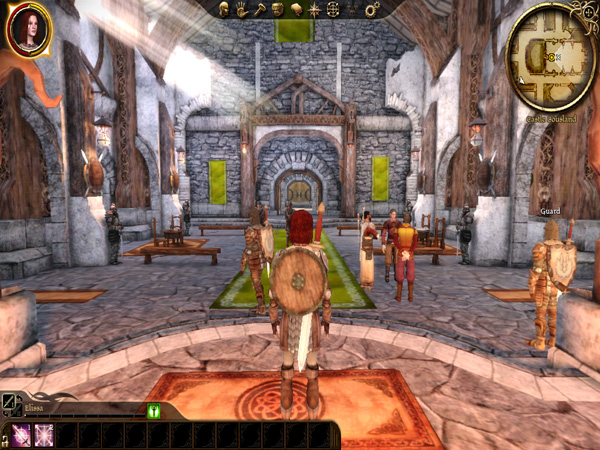
DAO has been a staple of our integrated graphics benchmark for some time now. The third/first person RPG is well threaded and is influenced both by CPU and GPU performance.
We ran at 1024 x 768 with graphics and texture quality both set to low. Our benchmark is a FRAPS runthrough of our character through a castle.
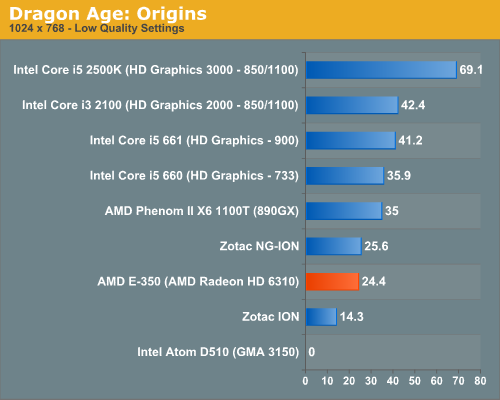
Our Dragon Age: Origins benchmark is quite CPU bound here and thus the E-350's Radeon HD 6310 doesn't look all that powerful. Luckily for AMD, DAO happens to be more of an outlier among current games as you're about to see.
The bare bones Atom D510 won't even run DAO. You'll see a number of games where compatibility is a problem for the D510. NVIDIA's ION does a lot better but it'll take a second generation ION to hang with the E-350. Zotac's NG-ION is actually a bit faster than the E-350, implying some driver/threading efficiencies as we're most definitely CPU bound on these low end parts.
Dawn of War II

Dawn of War II is an RTS title that ships with a built in performance test. I ran at the lowest quality settings at 1024 x 768.
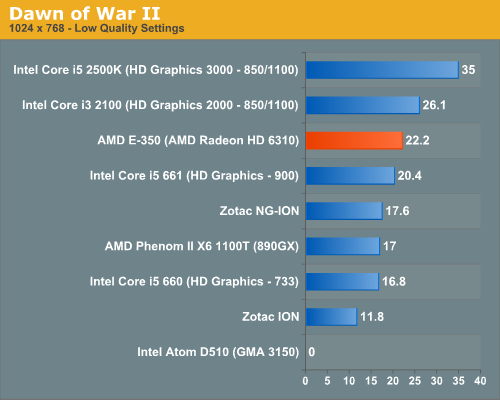
Oh what a difference moving a bottleneck makes. The AMD E-350, with its 75mm2 die is faster than Intel's Core i5 661 - the fastest implementation of Intel's HD Graphics. The E-350's performance isn't too far off the Core i3 2100 either. While none of these frame rates are what I'd call smooth, you can't argue with how competitive the E-350 is here.
Call of Duty: Modern Warfare 2

Our Modern Warfare 2 benchmark is a quick FRAPS run through a multiplayer map. All settings were turned down/off and we ran at 1024 x 768.
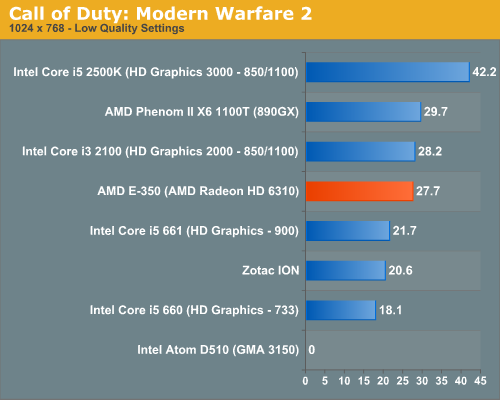
Modern Warfare 2 paints an even better picture for AMD. The E-350 offers virtually the same performance as Intel's Core i3 2100, and noticeably better performance than the Core i5 661. Need I mention that you get this at a much lower price than either of the aforementioned CPUs?
BioShock 2
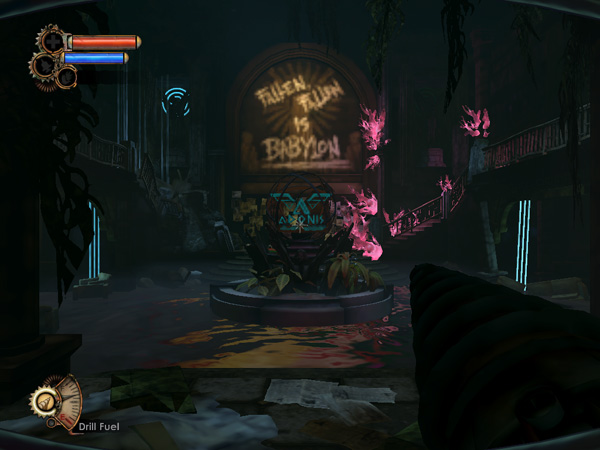
Our test is a quick FRAPS runthrough in the first level of BioShock 2. All image quality settings are set to low, resolution is at 1024 x 768.

Again the E-350 continues to hang with the best here. The frame rates are still not high enough to get excited, but the effort is top notch.
World of Warcraft
Our WoW test is run at fair quality settings (with weather turned down all the way) on a lightly populated server in an area where no other players are present to produce repeatable results. We ran at 1024 x 768.
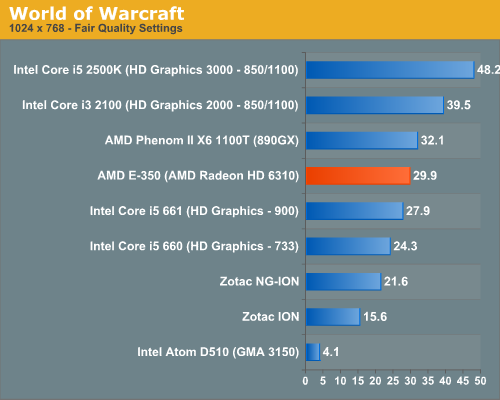
AMD's E-350 is faster than anything from the Clarkdale era, while just a bit slower than AMD's 890GX. Intel's HD Graphics 2000 is faster but at a much higher power consumption and pricetag of course. Intel's Atom D510 can complete our benchmark here but at a laughable 4.1 fps. Both the first and second generation ION platforms fall behind Brazos.
HAWX
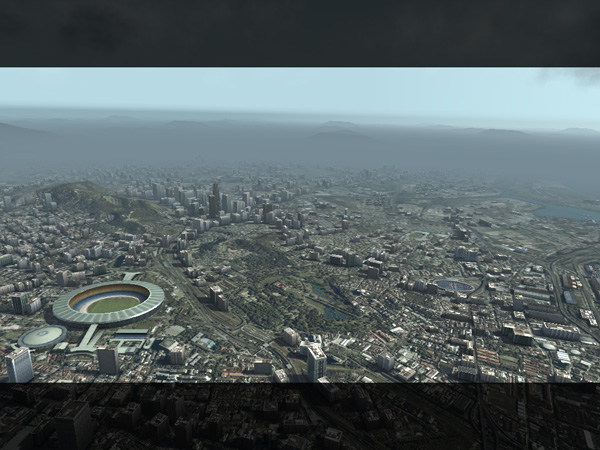
Our HAWX performance tests were run with the game's built in benchmark in DX10 mode. All detail settings were turned down/off and we ran at 1024 x 768.
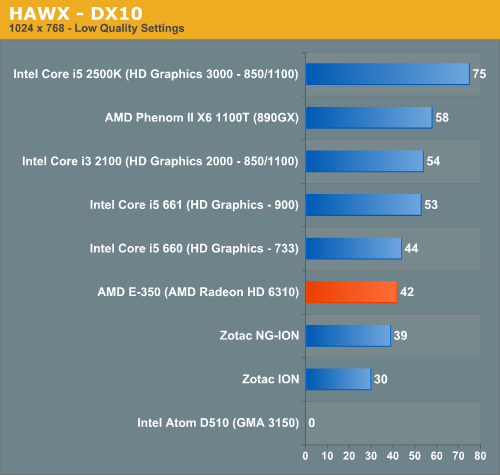
With HAWX CPU performance matters a bit more, pushing the E-350 just slightly behind the Core i5 660. The Radeon HD 6310 still delivers respectable performance in HAWX, especially considering its price point. The next-generation ION does come close in performance to the E-350, while the original ION is significantly slower.
Starcraft II

We have two Starcraft II benchmarks: a GPU and a CPU test. The GPU test is mostly a navigate-around-the-map test, as scrolling and panning around tends to be the most GPU bound in the game. Our CPU test involves a massive battle of 6 armies in the center of the map, stressing the CPU more than the GPU. At these low quality settings however, both benchmarks are influenced by CPU and GPU.
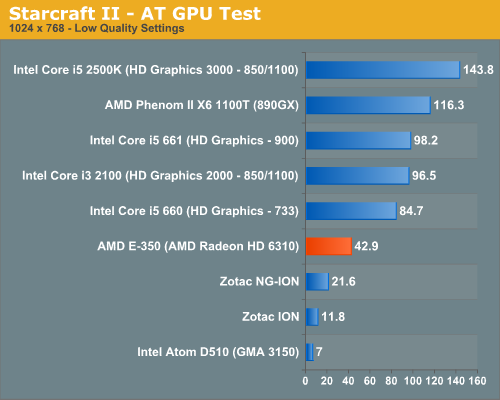
In our GPU specific test, the E-350 is significantly faster than anything Atom based. While the D510 can technically run this test, it does so at only 7 fps. Even the next-generation ION only manages 21.6 fps. The E-350 with its Radeon HD 6310 delivers nearly twice the frame rate of the fastest ION. The advantage isn't purely on the GPU side. As I mentioned before, Starcraft II can be very CPU bound at times. The Bobcat cores at work in the E-350 help give it a significant advantage over anything paired with Atom.
The CPU dependency is what separates the E-350 from its larger, more expensive competitors here. The gap only widens as we look at what happens in a big battle:
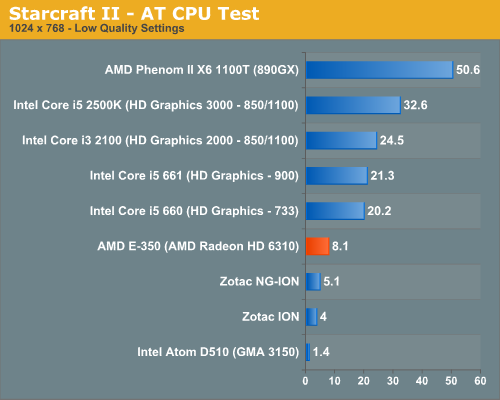
While you can play Starcraft II on any of these systems, to maintain frame rate throughout all scenarios you really need more CPU and GPU horsepower.
Call of Duty: Black Ops
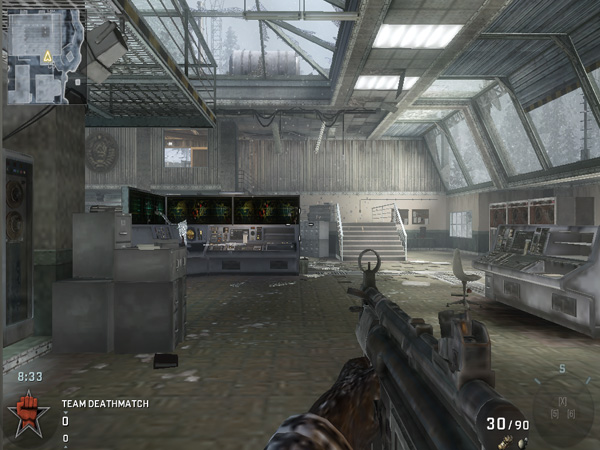
Our Black Ops test is a quick FRAPS runthrough on a private multiplayer server. The game was set to 1024 x 768 at the lowest quality settings.
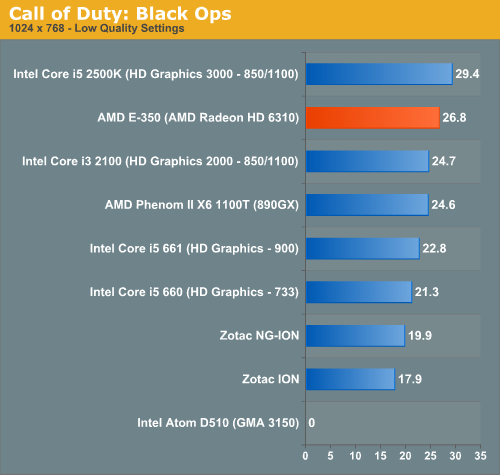
In Black Ops the E-350 does the best it has done thus far, nearly equaling the performance of Intel's HD Graphics 3000. In our Sandy Bridge Review I wondered if Intel was being limited by driver issues here as there's very little difference between the 3000 and 2000 GPUs. The E-350 benefits from all of the driver tweaks and experience AMD has from the Radeon side so it immediately puts its best foot forward. AMD's greatest ally in Fusion will be its driver experience.
Mafia II
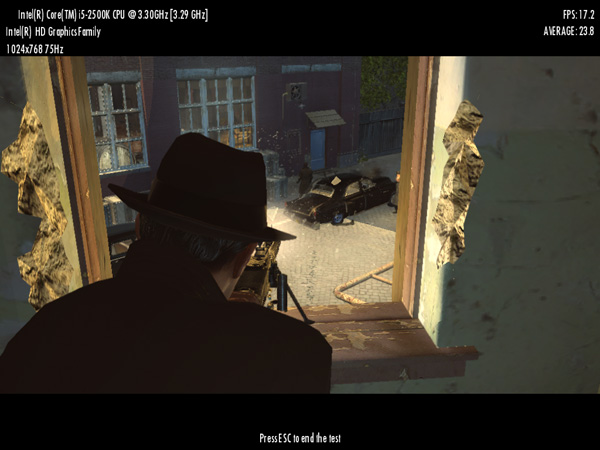
Mafia II ships with a built in benchmark which we used for our comparison:
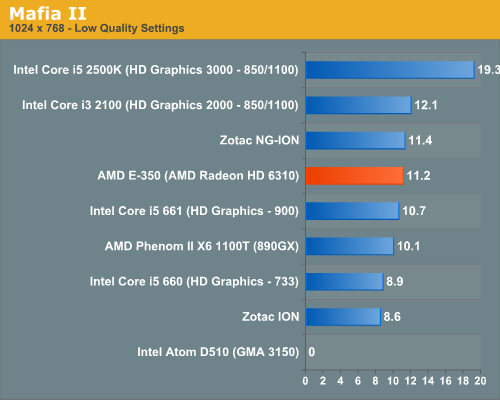
Mafia II doesn't run well on any integrated graphics platform, regardless of vendor. The E-350 does well vs. the competition but none of these platforms are playable, even at the lowest settings.
Civilization V
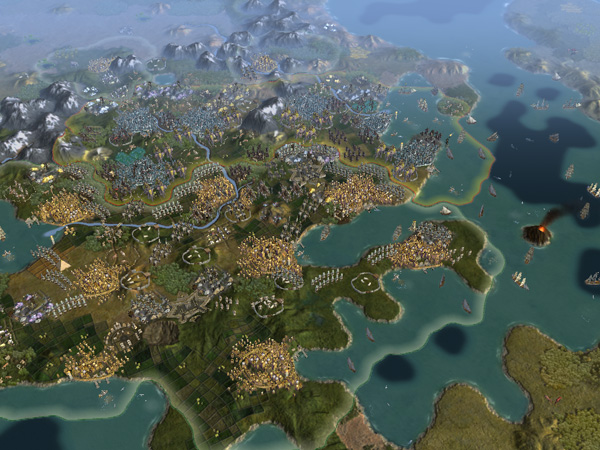
For our Civilization V test we're using the game's built in lateGameView benchmark. The test was run in DX9 mode with everything turned down at 1024 x 768:
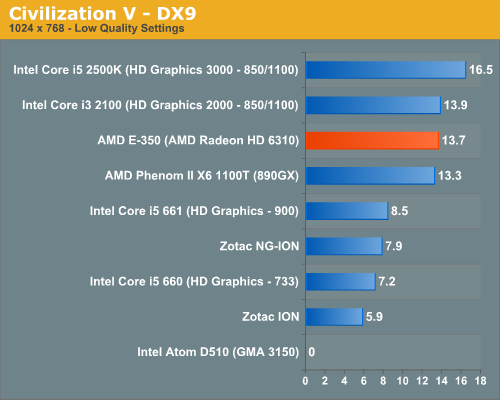
Civilization V doesn't run well on any integrated graphics platform, but the E-350 runs it at least as well (or as poorly?) as Intel's Core i3 2100. The Bobcat cores help with a lot of the heavy lifting here giving the E-350 a substantial lead over Atom.
Metro 2033
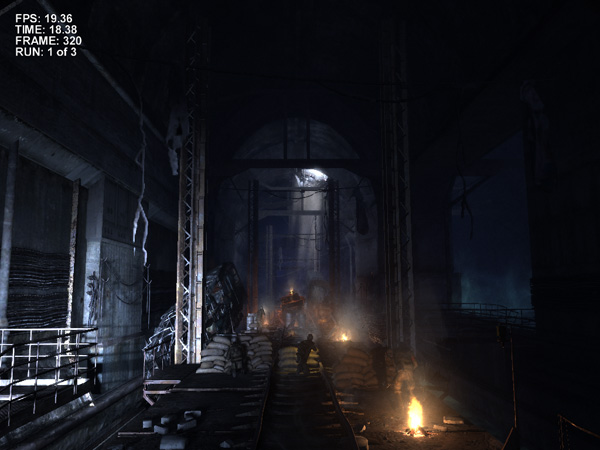
We're using the Metro 2033 benchmark that ships with the game.
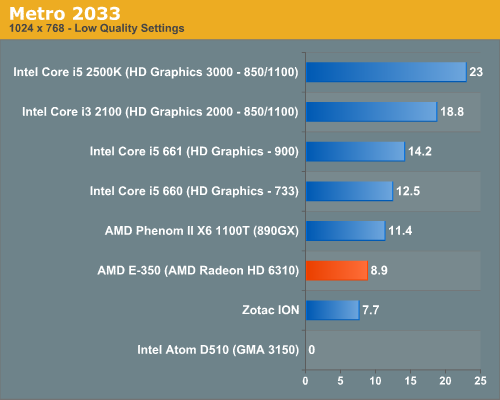
Metro 2033 is a bit too modern for these low end platforms. The E-350 is faster than ION but not in the realm of playability.
DiRT 2
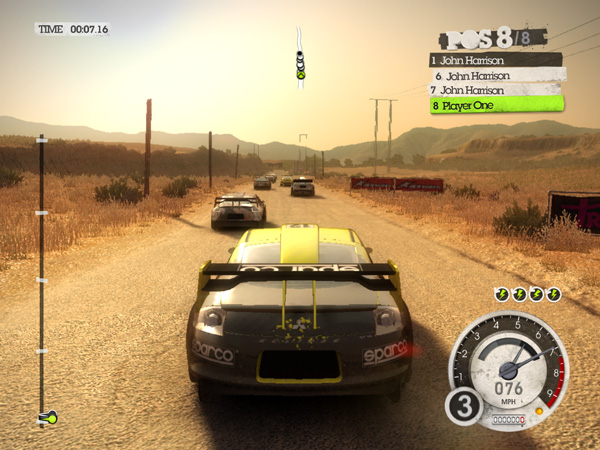
Our DiRT 2 performance numbers come from the demo's built-in benchmark:
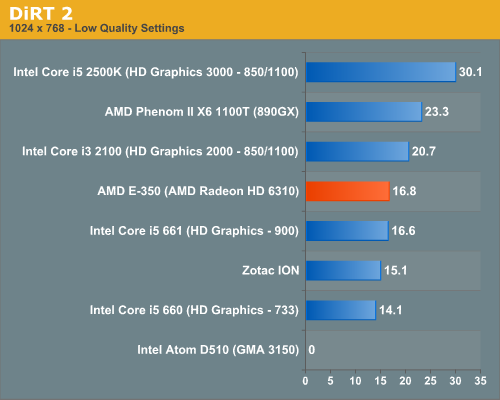


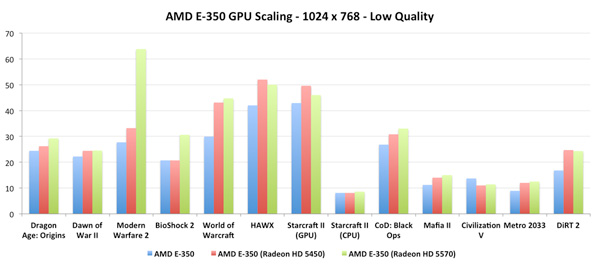








176 Comments
View All Comments
flyck - Friday, January 28, 2011 - link
at idle the SB cpu uses 30% more power (or 4W) (2400S), during playback the difference between the cpu will also be around 1W.the chip consumption is however not known.
duploxxx - Friday, January 28, 2011 - link
Nice review, always a good review from Anandtech, thxFor now brazos could use only another cpu speedbump to totally destroy all atom based solutions and even more get into the ULV regions. A wider APU platform offer (different clockspeeds) would be better though.
To crush next gen Atom I think AMD knows what to do, update like 69xx series on uarch for gpu, add higher speed or more core in the new 28nm package all combined with turbo modes by the end of this year and Intel will never have a chance unless they bring a new uarch.
bjacobson - Saturday, January 29, 2011 - link
meh, they can just compete with the ULV Pentiums.To me that's what Brazos is competing with performance wise-- of course it stomps Atom...so what's next? ULV chips...and it has a much harder time with them.
beginner99 - Friday, January 28, 2011 - link
...as mentioned before I do not see the benefit of playing MW 2 at 20 fps on a 1024x768 resolution. Who will do that? probably no one because it is still unplayable.I mean this thing is nice and better than Atom (assuming same price) but I think the GPU is a waste of die space. Why not beef up the decode engine? I mean this thing will be used mainly for media stuff and not for gaming. I mean not being able to play 1080p youtube perfectly is already fail for a nettop/htpc because that is a very, very likely usage scenario (1080p tv or screen).
More fixed function hardware fro media would be better maybe even something like QuickSync so you could actually trans-code on your htpc. Or said otherwise functionality you get with these broadcom cards, which quite a few atom system have.
I would still 100% choose this over Atom.
nitrousoxide - Friday, January 28, 2011 - link
Then it won't be an APU :)And AMD doesn't have smaller GPU...HD5400 Cedar is the smallest available design AMD has lol
While it can't run Modern Wardare 2, I'm quite satisfied with the fact that it can run L4D2, Warcraft 3, Starcraft 2 and I can even play Command and Conquer Red Alert 3 tuned to "medium".
sebanab - Monday, January 31, 2011 - link
I also think the 3D functions of the chip might as well not be there at all.But they should come in handy for Aero effects in Win7 and why not , Win8.
Shadowmaster625 - Monday, January 31, 2011 - link
1080p youtube is just too slow to be practical for anything other than watching trailers for the really big movies that come once a year, like Avatar. Most people's internet connections simply cannot keep up to stream realtime 1080p. And even if you did have the bandwidth, that dont mean that youtube is going to have it.720p is much more reasonable, though even then comcast 20mbps + youtube have trouble keeping that pipe filled most of the time. Most of the time I go with 480p just because less wait is more important than the added quality.
krumme - Friday, January 28, 2011 - link
I like the review, epecially the new HD bm and the recommandations. Looking at the hd bm themselves one had to wonder if 7200rpm was not enough for the bobcat? but i guess there is room for personal interpretation. I think Anand really likes his ssd more than i do :)I still feel the emphasis on multithreaded and heavy workloads is a little to much, and the same for the emphasis on the gaming side. But ofcourse there must be some readers that will use this for for gaming.
I hope AMD get this bobcat on lower leaking gf 32nm process, so we can have even better battery life.
bjacobson - Saturday, January 29, 2011 - link
You know I've found my 160GB 5400RPM drive to be plenty fast for my Atom. I doubt a 7200RPM would be too terribly much of a bottleneck. Might impact battery life though compared with SSD on a laptop.I found the multi-threading very useful-- it showed us that even in perfect-scalable applications (Cinebench), the e350 still stomps a dual core dual threaded Atom. That's the conclusive evidence I was looking for that this is a better chip.
macs - Friday, January 28, 2011 - link
My thought:- AMD E-350 itx board: 100-130 $
- Intel Sandy Bridge Pentium G620T (rumored release date 2/27/11, dual core, 35w TDP) 70$ paired with a H67 ITX board like the Foxconn one (75$) TOT:145$
I suspect that we will have similar power cosumption (probably Idle is even better for Intel) but the performance are way better in Sandy Bridge and totally worth the 10/50$ price difference.
Am I wrong? (sorry for my poor English)